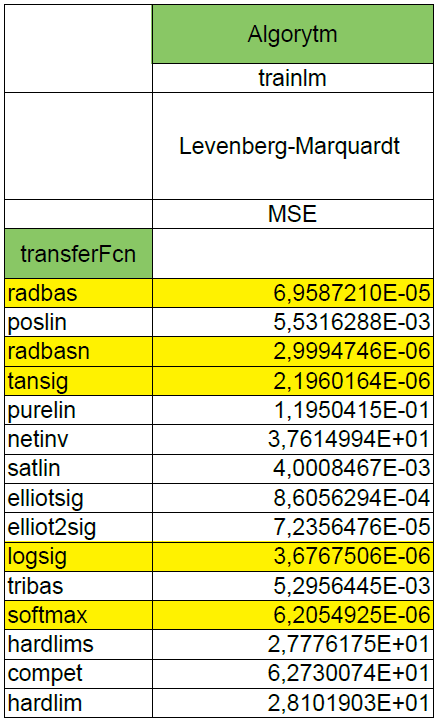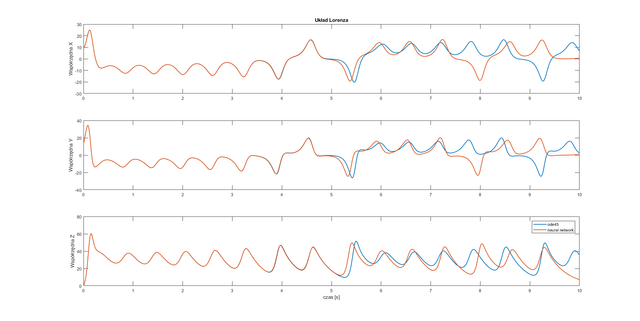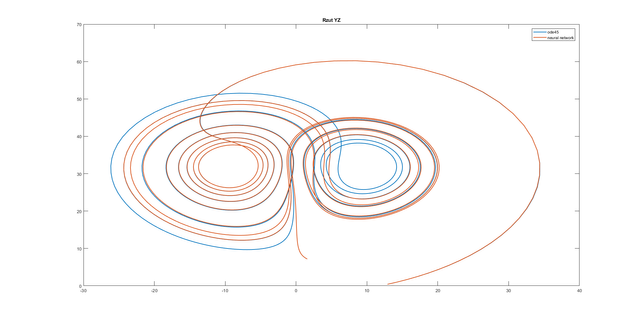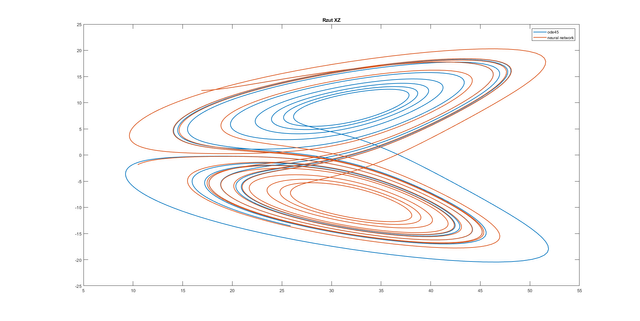How to learn neural network solving ODE system?

This is Lorenz attractor presented by Edward Lorenz in 1963. The system of equations which leads to get such graphs is called Lorenz system and consist of three non-linear differential equations that modeling in the simplest possible way a phenomenon of thermal convection in the atmosphere. For some set of parameters, the system of ODE equations behaves chaotically, and the plot of variables in the phase space presents a strange attractor. This attractor is the particular solution of Lorenz system and its shape is a little bit similiar to butterfly or figure eight.
This is the Matlab code to generate the plot.
% Atraktor Lorenza
dt=0.005;
T=10;
t=0:dt:T;
b=8/3;
sig=13;
r=33;
Lorenz_atraktor = @(t,x) ([ sig * (x(2) - x(1))
r * x(1)-x(1) * x(3) - x(2)
x(1) * x(2) - b*x(3) ]);
NofT = 10; % Number of trajectories (learning data)
% matrices for learning data
input = zeros(NofT * T / dt,3) ;
output = zeros(NofT * T / dt,3) ;
figure
for jj=1:NofT
InitConds = (17+17)*(rand(3,1)) - 17; % initial conditions were created randomly
[t,y] = ode45(Lorenz_atraktor, t, InitConds);
input(1 + (jj-1)*(T/dt):jj * T/dt,:) = y(1:end-1,:);
output(1 + (jj-1)*(T/dt):jj * T/dt,:) = y(2:end,:);
plot3(y(:,1), y(:,2), y(:,3)), hold on
plot3(InitConds(1), InitConds(2), InitConds(3), 'ro')
end
grid on
I decided to create neural network in Matlab enviroment and check if it is possible to learn this network solving Lorenz system for parameters in which the system shows the features of chaos.
At the beginning of the program the system of differential equations is solved by the procedure ode45. At the same time, the learning data matrix is created, which will be used to train the neural network. The learning data are simple three numbers, the solution matrix "y" is simply moved 1 row down, the network have to learn how to get the next point P(n+1) from the point P(n).
The initial conditions are random (-17, 17) for each loop execution. Thus, each time the program is compiled, we have new trajectories.
Then, the neural network is subjected to the learning process. At the beginning we need to define network parameters such as network type, number of layers, number of neurons in the layer, learning algorithm and transfer function (also known as activation function). These are the basic parameters. After the learning process, the network is tested. We check how it will cope if we give it completely new data at the input. At this point in the experiment, we can check the performance of the network in many ways, I used a simple criterion - mean square error. The effect of the neural network is compared with the results of the 'ode45' procedure for the same input data.
First step of experiment consisted in defining a 1-layer network with the number of neurons equal to 10 and changing the transfer function. The learning algorithm was chosen arbitrarily. This is the Levenberg-Marquardt algorithm which convergence is the fastest from all algorithms offered by Matlab.

The criterion, of course, was MSE. This led to the generation of a table in which we can check which transfer function copes best with such problem. Parameters of the algorithms have been changed for the necessity of the experiment. The learning process has several conditions that cause its interruption. In order to check clearly the given transfer functions, I introduced several modifications to the parameters of the algorithms. The minimal gradient has been set to 0, the number of iterations has been set to 1000, the maximum number of errors out of range after which the learning process is interrupted has been increased from 6 to 50.
After such experiments I chose the 5 best transfer functions, the 5-layer and 3-layer neural networks were made and the learning process was repeated. The effects compared to the 1-layer network for 5-layer NN are... worse. But for 3-layer NN are better. A bit of confusion will not hurt, right? :)
With the 5-layer and 3-layer networks, one more modification has been made: the number of neurons in each layer has been increased to 13.
liczba.warstw = 3;
liczba.neuronow = 13;
LY = liczba.neuronow * ones(1, liczba.warstw);
net = feedforwardnet(LY, 'trainlm');
net.layers{1}.transferFcn = 'logsig';
net.layers{2}.transferFcn = 'radbasn';
net.layers{3}.transferFcn = 'tansig';
net.trainParam.min_grad = 0;
net.trainParam.epochs = 1000;
net.trainParam.max_fail = 50;
[net, tr] = train(net, input', output');
view(net)
plotperform(tr)
mse = tr.best_vperf
figure
InitConds = (17+17)*(rand(3,1)) - 17;
[t,y] = ode45(Lorenz_atraktor, t, InitConds);
plot3(y(:,1), y(:,2), y(:,3),'b'), hold on
plot3(InitConds(1), InitConds(2), InitConds(3), 'bo', 'Linewidth',1.5)
plot3(y(end,1), y(end,2), y(end,3), 'bx', 'Linewidth',1.5)
grid on
ynn(1,:) = InitConds;
for jj=2:length(t)
y0 = net(InitConds);
ynn(jj,:) = y0';
InitConds = y0;
end
plot3(ynn(:,1), ynn(:,2), ynn(:,3),'r')
plot3(ynn(end,1), ynn(end,2), ynn(end,3), 'rx', 'Linewidth', 1.5)
legend('ode45','InitConds','LastPointODE','neural network','LastPointNN')
figure
subplot(3,1,1)
plot(t,y(:,1), t, ynn(:,1),'Linewidth',1.5)
ylabel('Współrzędna X');
title('Układ Lorenza');
subplot(3,1,2)
plot(t,y(:,2),t,ynn(:,2),'Linewidth',1.5)
ylabel('Współrzędna Y');
subplot(3,1,3)
plot(t,y(:,3),t,ynn(:,3),'Linewidth',1.5)
xlabel('czas [s]');
ylabel('Współrzędna Z');
legend('ode45','neural network');
figure
plot(y(:,1), y(:,2), ynn(:,1), ynn(:,2),'Linewidth',1.5)
legend('ode45','neural network');
title('Rzut XY');
figure
plot(y(:,2), y(:,3), ynn(:,2), ynn(:,3),'Linewidth',1.5)
legend('ode45','neural network');
title('Rzut YZ');
figure
plot(y(:,3), y(:,1), ynn(:,3), ynn(:,1),'Linewidth',1.5)
legend('ode45','neural network');
title('Rzut XZ');












Conclusion: All of the used neural networks have good approximation for half of the considered time.
Next, the sequence of multilayer neural network layers is not insignificant. Intuition suggests using the sieve method — i.e. sieving the particles starting from the sieve with the largest mesh and ending with the smallest mesh. However, this is not a completely good approach when constructing a multilayer neural network. The 5-layer network has been arranged in this way — based on MSE. The question is whether the reverse arrangement should be considered optimal? In my opinion, in neural networks and general in artificial intelligence algorithms there are many randomities, many factors are chosen experimentally having no idea why the results are good at a given value of some coefficient, and bad at another its value. If the algorithm has such a large number of unknowns, it is impossible to give an unambiguous answer to the problem.
Moral: try to use mathematics instead.
The machine learning in your post is applied to find numerical solutions of an ODE. So the chaos here is just something extra? How does the chaotic phenomena in the Lorenz system relate to the machine learning being applied?
Very good question. The chaotic system is an additional difficulty for the neural network. The chaotic system is characterized by a complete lack of any determinism. Having the solution of the system of equations for the time t=t1, we are not able to determine functions e.g. for time t=t1+1. In the case of Lorenz system, the particle will be on the first or second loop. I do not know if it is clearly visible on the plots (the lines are strongly compacted), but you can see that the trajectory of the neural network in some places makes a mistake regarding to the loop. I created Lorenz system in which we have not chaos. The 1-layer neural network with the logsig transfer function has dealt with it much better. MSE = 3.666672309560181e-07 with only 1-layer (!).
As you can see, it is highly doubtful to say that neural networks are suitable for non-deterministic processes.
Do you want to comment on this statement you made? In my understanding Chaos is completely deterministic.
Could you explain a little further? In my understanding - if chaos were deterministic then it wouldn't be chaos. If we talk about Lorenz attractor, we don't know where the function will go because we have 2 focal points.
Chaos is completely deterministic. Chaotic trajectories follow a proper set of rules. Lorenz attractor is also a deterministic system (unless you add noise to it). Chaos has only to do with initial conditions in my understanding. I am also tagging @mathowl here. Maybe he can simplify things.
I didn't read that comment thoroughly. Thanks for pointing that mistake out.
From a theoretical viewpoint this is incorrect. ODEs are deterministic this means that given an initial condition all futures are fixed. I think you are confusing determinism with sensitive dependence on initial conditions (which is a property of Chaos). This means that if you take two solutions with initial conditions close to each other then they can exhibit different behavior. Which is exactly what you see in the Lorentz system for chaotic parameters.
From a numerically point of view you could say that when chaos is present your algorithm does not give a good determination of the solution for a given initial condition. However, even in that setting we do not call the algorithm non-deterministic since this is all caused by sensitive dependence on initial conditions.
In addition, sincethe ODE exhibits sensitive dependence on intial conditions it comes as no surprise that the neural network does not give satisfying results.
So you might wonder why a deterministic system can be called chaotic. Well in the real world we cannot measure the initial conditions exactly because of the uncertainty principle. So sensitive dependence means that even a small change in intial conditions can lead to different behaviour and since we cannot measure the initial conditions exactly it makes sense that we can call a deterministic system chaotic.
Thank you very much @mathowl and @dexterdev! I didn't investigate the chaos closely. And you are right - chaos isn't nondeterministic. But let me ask one more question - for clarification. Only initial conditions determine chaos in Lorenz system? Because in the code in comment (https://steemit.com/steemstem/@romualdd/how-to-learn-neural-network-solving-ode-system#@romualdd/re-mathowl-re-romualdd-how-to-learn-neural-network-solving-ode-system-20180706t130006093z) I set fixed and not wide initial conditions - the result was a system with one focal point. But if I change "r" parameter in the same system - the second focal point was apperead. So the system has become chaotic again (because of parameter in ODE system, not initial conditions). Am I right?
In the Lorenz system there is a subset of R^3 for which the orbits/solutions exihibit chaos. Not all initial conditions correspond to Chaos, the easiest way to see this is to compute the fixed points of the Lorenz system. For a fixed point the vector field is zero so the solution is stationary so for these points the system is certainly not chaotic.
Thank you very much for clarification! :)
This post has been voted on by the steemstem curation team and voting trail.
There is more to SteemSTEM than just writing posts, check here for some more tips on being a community member. You can also join our discord here to get to know the rest of the community!
Hi @romualdd!
Your post was upvoted by utopian.io in cooperation with steemstem - supporting knowledge, innovation and technological advancement on the Steem Blockchain.
Contribute to Open Source with utopian.io
Learn how to contribute on our website and join the new open source economy.
Want to chat? Join the Utopian Community on Discord https://discord.gg/h52nFrV